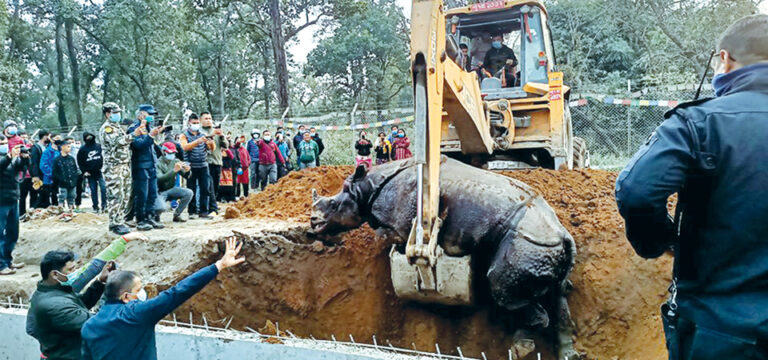
On Sunday, a rhinoceros died after falling in a drain dug in the Barandabhar forest area along the East-West Highway.
In March last year, a female rhinoceros died after falling into a septic tank at the Tiger Land Safari Resort in Jagatpur, near Kasara. Four years earlier in 2018, another rhino was rescued from the septic tank of a hotel in Sauraha.
These are just some examples of wild animals dying due to a lack of wildlife-friendly infrastructure in the buffer zone of Chitwan National Park (CNP), claimed Haribhandra Acharya, chief conservation officer at CNP.
“Yes, we need infrastructure and development but don’t those structures need to be friendly to the animals living in the area?” he questioned. “How long can this carelessness be tolerated?”
Acharya alleged that the rhino died on Sunday because the road was being widened without fulfilling the necessary criteria and following the appropriate procedure. The government has asked the Deputy Director General of the Department of Forests and Soil Conservation to investigate into the incident and a five-member task force has been formed under Rajendra KC.
Acharya is also a member of the force and he stated that the tragedy could have been avoided if the concerned authorities had paid attention to the environmental impact assessment (EIA) report before moving forward with the work.
In CNP and the surrounding forests alone, 36 animals have died in the past three and a half years due to wildlife-unfriendly structures. “Protected animals like one-horned rhinos and leopards die every year due to human carelessness,” complained CNP spokesperson Ganesh Tiwari.
The National Parks and Wildlife Conservation Act allows for the punishment of people and organisations if their negligence leads to the death of protected animals. “But this law is not implemented effectively,” Tiwari said.
When the rhino died after falling into the Tiger Land Safari Resort’s septic tank, Chitwan National Park conducted an investigation and found that a weak lid was to blame. It then filed a case against six people involved with the resort for their negligence at the District Court of Chitwan in April last year. But the very next day, the court released the six on a bail of Rs. 1 million.
Similarly, the law also requires any entity carrying out any construction in protected areas or their buffer zones to obtain approval from the respective national parks. However, at Chitwan, only a few development projects have obtained the necessary permits. Many of the 13 bridges and sections of the postal highway under construction in Madi have not carried out the required EIA too.
But Madi Municipality Mayor Thakur Dhakal disputed this assertion and said that the EIA of six of 13 structures had been completed or was in the process of being complete.
Former Chief Conservation Officer of CNP Ananath Baral argues that the problem lies with the local government not paying heed to the development of wildlife-friendly structures. “The local government aims for development but let them not view the national parks as standing against this,” he said.
Baral recalled how projects like the Birgunj-Triveni Road and Malekhu-Bhandara-Thori Road as well as the construction of a railway line passing through the park and several bridges at Triveni and Golaghat had been stopped because of a lack of EIA in the past. “Unfriendly structures should be stopped like this at the present too,” he argued.
Likewise, conservationists who have long been active in wildlife protection say that conservation is more important than our traditional notions of development.
Dr. Bijay Kumar Shrestha, a veterinarian at the Chitwan park, stressed that there should not be any negligence when building infrastructures around the park. He also believed that accidents could be prevented by constructing underpasses and overpasses in the areas where animals roamed.
Source : TRN,






